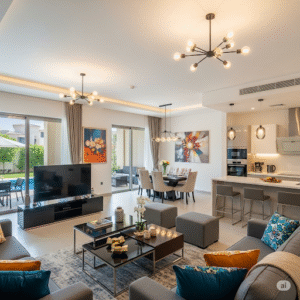The eternal dance between aesthetic magnificence and comfortable living has redefined contemporary interior design philosophy. Modern homeowners no longer accept the false choice between spaces that look stunning but feel cold, or cozy environments that lack visual sophistication. Instead, today’s most compelling interiors achieve an intricate balance where beauty amplifies warmth, and comfort enhances visual appeal.
The Psychology of Comfort-Driven Aesthetics
Human beings instinctively gravitate toward environments that stimulate multiple senses simultaneously. Visual beauty alone cannot sustain long-term satisfaction in living spaces. Research in environmental psychology reveals that rooms combining striking design elements with tactile warmth create deeper emotional connections. This phenomenon explains why minimalist spaces often feel unwelcoming despite their photogenic qualities, while overly cluttered comfort zones can feel visually overwhelming.
The secret lies in understanding how different design elements trigger emotional responses. Cool colors and sharp lines may create visual drama, but without corresponding warm textures or intimate lighting, they can feel austere. Conversely, soft furnishings and warm color palettes create immediate comfort but require architectural structure and visual anchors to prevent spaces from feeling shapeless.
Successful designers recognize that true luxury emerges when inhabitants feel both visually inspired and physically nurtured. This dual satisfaction requires careful orchestration of elements that serve both aesthetic and comfort functions.
Material Conversations and Textural Narratives
Contemporary interior design increasingly emphasizes material storytelling, where each surface contributes to both visual narrative and sensory experience. Natural materials like reclaimed wood, hand-hewn stone, and organic textiles provide immediate warmth while adding authentic character that manufactured materials cannot replicate.
The layering technique has become fundamental to achieving this balance. Smooth marble countertops paired with rough-textured ceramic vessels create visual interest while the contrast itself generates warmth through human imperfection. Similarly, sleek metal fixtures gain approachability when surrounded by soft textiles or natural wood grains.
Texture manipulation extends beyond obvious fabric choices. Wall treatments now incorporate everything from lime plaster to grasscloth wallcoverings, creating surfaces that invite touch while commanding visual attention. These materials age beautifully, developing patina that enhances both character and comfort over time.
Smart material selection also considers practical warmth. Natural fibers regulate temperature better than synthetics, while materials like wool and linen provide both visual sophistication and physical comfort. The key is selecting materials that serve dual purposes, eliminating the need to choose between beauty and functionality.
Light as the Universal Harmonizer
Lighting design has evolved into perhaps the most critical element for balancing beauty and warmth. Modern lighting schemes layer multiple sources to create environments that transform throughout the day, supporting both functional needs and emotional well-being.
Ambient lighting provides the foundation, establishing overall mood and spatial perception. However, task lighting and accent lighting add layers of visual interest while serving practical purposes. The interplay between these layers creates depth and visual complexity while maintaining comfortable illumination levels.
Natural light remains the gold standard for achieving this balance. Strategic window placement and treatments can maximize daylight while controlling glare and heat gain. When natural light is limited, quality artificial lighting can replicate its warmth and variability.
Contemporary fixtures themselves have become sculptural elements that contribute to room aesthetics even when unlit. Pendant lights, sconces, and table lamps now serve as functional art pieces, eliminating the traditional separation between utilitarian and decorative elements.
Color Theory for Emotional Architecture
Modern color theory extends far beyond simple warm versus cool classifications. Today’s sophisticated palettes create emotional journeys through space, using color temperature, saturation, and contrast to guide inhabitants through different experiences within single environments.
Neutral foundations provide stability and sophistication while allowing colorful accents to create warmth and personality. However, contemporary neutrals include complex undertones that prevent spaces from feeling sterile. Greiges, warm whites, and sophisticated beiges provide visual calm while maintaining enough color complexity to feel alive.
Accent colors can be introduced through easily changeable elements like pillows, artwork, and seasonal decorations, allowing spaces to evolve with inhabitants’ needs and preferences. This flexibility ensures that comfort levels can be adjusted without major renovations.
The strategic use of color temperature in lighting further enhances this balance. Cooler light can highlight architectural features and artwork during daytime hours, while warmer evening lighting creates intimate, comfortable atmospheres for relaxation.
Furniture as Functional Sculpture
Contemporary furniture design increasingly blurs the line between functional necessity and artistic expression. Pieces that serve as visual focal points while providing exceptional comfort represent the pinnacle of balanced design thinking.
Modular seating systems allow inhabitants to reconfigure spaces for different activities and group sizes, maintaining visual coherence while adapting to changing needs. Ottoman-style coffee tables provide additional seating when needed while maintaining clean lines during everyday use.
Storage solutions have become increasingly sophisticated, integrating seamlessly into room designs while maintaining accessibility. Built-in elements can provide architectural interest while serving multiple functions, from display to concealment.
The scale and proportion of furniture pieces significantly impact both visual balance and physical comfort. Oversized seating can create dramatic visual impact while providing luxurious comfort, but requires careful spatial planning to avoid overwhelming room proportions.
Heating Solutions That Enhance Design Aesthetics
Modern heating systems have transcended their purely functional origins to become integral design elements. Traditional radiators often disrupted interior aesthetics, forcing designers to choose between effective heating and visual appeal. Contemporary solutions eliminate this compromise entirely.
The Cornel Column Radiator represents this evolution perfectly, combining superior heating performance with architectural elegance. These sophisticated heating elements can serve as room focal points while providing efficient warmth distribution. Their classic column design adds vertical emphasis to spaces while their refined proportions complement both traditional and contemporary interior schemes.
Radiant floor heating systems provide invisible warmth that enhances comfort without impacting visual design. Heated bathroom floors, in particular, add luxury while freeing wall space for decorative elements or storage.
Fireplace design has similarly evolved, with contemporary gas and electric options providing ambiance and supplemental heating while requiring minimal space and maintenance. These elements create natural gathering spots that enhance both social warmth and visual interest.
Smart Integration for Seamless Living
Technology integration now supports both aesthetic and comfort goals simultaneously. Smart thermostats learn inhabitant preferences while optimizing energy efficiency. Automated lighting systems adjust throughout the day to support circadian rhythms while maintaining visual appeal.
Hidden technology infrastructure preserves clean design lines while providing modern convenience. Wireless charging surfaces integrated into furniture, concealed speakers, and retractable screens allow spaces to remain visually calm while supporting contemporary lifestyles.
Home automation systems can coordinate heating, lighting, and window treatments to optimize both comfort and energy efficiency throughout different seasons and times of day.
Seasonal Adaptability and Long-term Satisfaction
Successful interior design accommodates seasonal changes and evolving needs. Lightweight throws and pillows can add warmth and color during colder months while being easily stored during warmer seasons. Furniture arrangements can be adjusted to optimize solar gain in winter and air circulation in summer.
Plants and natural elements provide year-round beauty while contributing to air quality and psychological well-being. Seasonal flower arrangements and foliage changes provide natural variety without requiring design overhauls.
Conclusion
The most successful contemporary interiors reject the false choice between beauty and warmth, instead creating synergistic environments where each element enhances the others. This holistic approach requires careful consideration of materials, lighting, color, furniture, and technology, but the results justify the additional complexity.
Spaces that achieve this balance provide lasting satisfaction, adapting to changing needs while maintaining their essential character. They support both practical daily life and aesthetic inspiration, creating homes that nurture inhabitants while impressing visitors. This represents the future of interior design: environments that serve human needs completely while elevating everyday experiences through thoughtful beauty.
The key is recognizing that true luxury lies not in choosing expensive materials or following trends, but in creating spaces that respond to both visual and physical needs with equal sophistication. When beauty and warmth work together, they create environments that feel both inspiring and profoundly comfortable.

